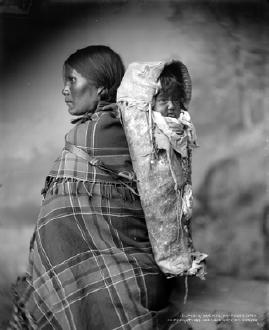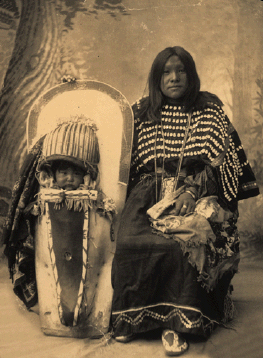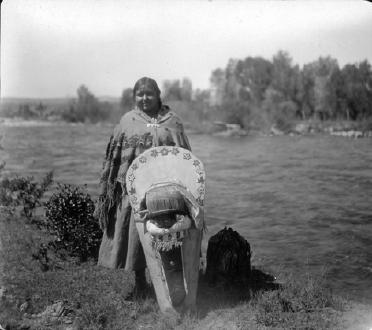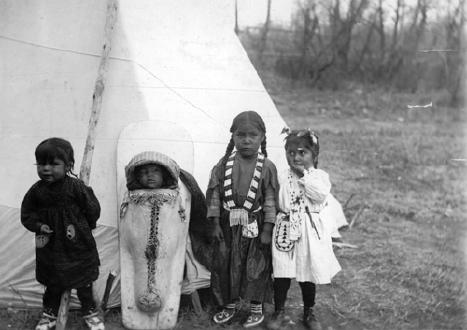Infants
What do these photos tell you about how Indian infants were cared for?
An Ute Mother With Her Baby
This is a photo of a Ute Indian mother and her baby. The baby is strapped to the mother's back in a cradle board.

Photo Credit: Colorado Historical Society
More About This Topic
A cradle board was made before the baby was born. It usually was a gift from women relatives. Making the board also was a ceremony. As they worked, the women prayed that the child might have a long life.
Their Own Words
"It kept the baby safe from falls or accidents, and comfortable when he traveled. Strapped in his cradle, he learned to look at and listen to everything that went on around him, and he grew straight and strong."
Source: Althea Bass, The Arapaho Way: A Memoir of an Indian Boyhood [by Carl Sweezy] (New York: Clarkson N. Potter, Inc., 1966), p. 30-31.
An Ute Baby On Cradle Board
This Ute baby looks very comfortable in its cradle board. The mother probably wanted to show off the cradle board as well as her baby. It also helped keep the baby quiet while the photo was taken.

Photo: Colorado Historical Society
More About This Topic
A cradle board was a useful device. A mother could attach it to her back or hang it on her saddle when she was traveling. When she was working, she could hang it on a tree limb or stand it against a tree.
A Fancy Cradle Board
This is a fancy cradle board. It is decorated with beads in designs that look like flowers. It also has fringes.

Photo: Colorado Historical Society
More About This Topic
Most cradle boards were decorated. A long time ago, cradle board makers decorated them with porcupine quills. The quills were died with vegetable coloring. After the arrival of Europeans, they used colored glass beads to make designs.
Their Own Words
"Nearly every Arapaho mother had a carrier, or what white people call a cradle board, for her baby…. Usually the skin that covered the carrier was decorated with quill or bead designs. Sometimes a kind of veil was fastened over the top to let down as a cover for the baby’s face when he needed protection from wind or sun."
Source: Althea Bass, The Arapaho Way: A Memoir of an Indian Boyhood [by Carl Sweezy] (New York: Clarkson N. Potter, Inc., 1966), p. 30.
Ute Children
The Ute children in this photo are standing beside a tepee. The youngest child is in a cradle board.

Photo: Colorado Historical Society
More About This Topic
The child in the cradle board in this photo probably was old enough to walk. Toddlers as well as little babies were strapped into cradle boards. It kept them from wandering off when their mothers were too busy to watch them.

